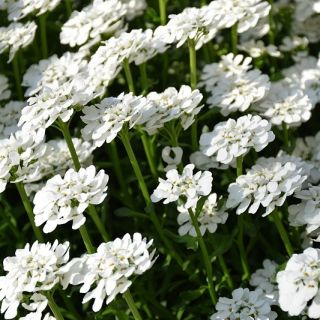The Hyacinth Flowered Candytuft, known by its Latin name Iberis amara hyacinthiflora, is a remarkable annual plant that captivates every gardening enthusiast with its charm. It grows to a height of 20-30 cm, and its vigorously spreading stems form lush carpets that beautifully complement borders, edges, and rock gardens. The small, white flowers are gathered in attractive umbels, adding elegance and freshness to the garden throughout the summer. The Hyacinth Flowered Candytuft is an excellent choice for those who value not only aesthetics but also practicality, as it is relatively easy to cultivate.
Sowing
The Hyacinth Flowered Candytuft is best sown directly into the ground. The seeds should be gently rubbed into the soil to ensure they receive sufficient light for germination. Regular watering accelerates the growth process, and the first seedlings appear after approximately 10-15 days.
Sowing Depth
The seeds of the Hyacinth Flowered Candytuft should be sown at a depth of 0.5 cm. Such shallow placement in the soil ensures adequate access to light and nutrients.
Direct Sowing Period
When is the best time to sow Hyacinth Flowered Candytuft seeds directly into the ground? The optimal sowing period is in April and May. During this time, the soil temperature is conducive to rapid seed germination, allowing for lush plant growth in a short period.
Plant Spacing
When sowing, it's important to remember the correct spacing, which for the Hyacinth Flowered Candytuft is 10x15 cm. Providing adequate distance between plants allows for their free development and prevents competition for nutrients.
Companion Planting
The Hyacinth Flowered Candytuft pairs well with other annuals and perennials, such as lobelia, marigolds, and tagetes. Such combinations create harmonious compositions that adorn the garden throughout the summer.
Site Conditions
The Hyacinth Flowered Candytuft thrives best in sunny locations but also tolerates partial shade. It prefers slightly alkaline, well-drained, and moderately moist soil. Appropriate fertilisation is essential to provide the plant with all necessary nutrients.
Growing Tips
The Hyacinth Flowered Candytuft is an easy-to-grow plant that does not require specialised care. Regular watering and the removal of spent blooms extend the flowering period. The plant is resistant to short-term droughts, making it an ideal choice for less demanding sites.
Plant Height
The Hyacinth Flowered Candytuft reaches a maximum height of 20-30 cm, making it an excellent addition to both low borders and larger garden compositions.
Flowering Period
The flowering period for the Hyacinth Flowered Candytuft is from June to August. During this time, the plant delights with an abundance of small, white flowers forming impressive umbels.
Usage
The Hyacinth Flowered Candytuft is versatile in garden applications. It is perfect for borders, edges, and rock gardens. Its compact growth and abundant flowering also make it an ideal choice for container gardening, allowing for decoration of balconies and terraces.
Resistance to Diseases
The Hyacinth Flowered Candytuft is characterised by good resistance to most garden diseases. With proper care and suitable growing conditions, it is rarely attacked by pests, making it a reliable plant in any composition.
Good to Know
The Hyacinth Flowered Candytuft not only adorns the garden but also attracts beneficial insects such as bees and butterflies. This supports biodiversity and the natural ecosystem of the garden. Additionally, it is a honey plant, which further enhances its value in the garden.
Why Buy from Garden Seeds Market?
Purchasing Hyacinth Flowered Candytuft seeds from Garden Seeds Market guarantees quality and satisfaction. The seeds are sourced from reputable suppliers and undergo thorough quality testing, ensuring high germination rates. The shop also offers fast and secure deliveries, and satisfied customers praise the professional service and wide range of products. Garden Seeds Market provides attractive promotions and access to gardening advice, facilitating plant cultivation.
The package contains 1 g of seeds. The packaging includes information on cultivation guidelines and the sow-by date.


.jpg)
.jpg)
.jpg)
.jpg)
.jpg)

.jpg)
.jpg)
.jpg)
.jpg)
.jpg)

